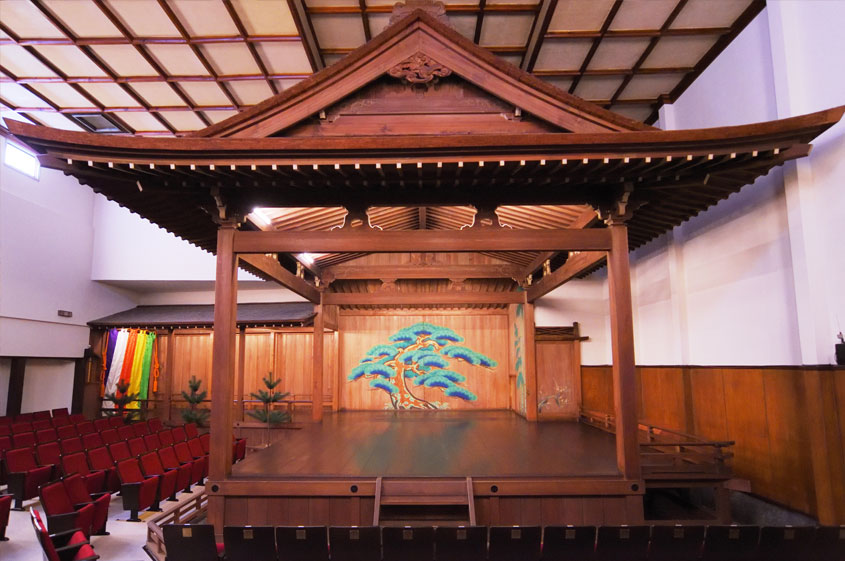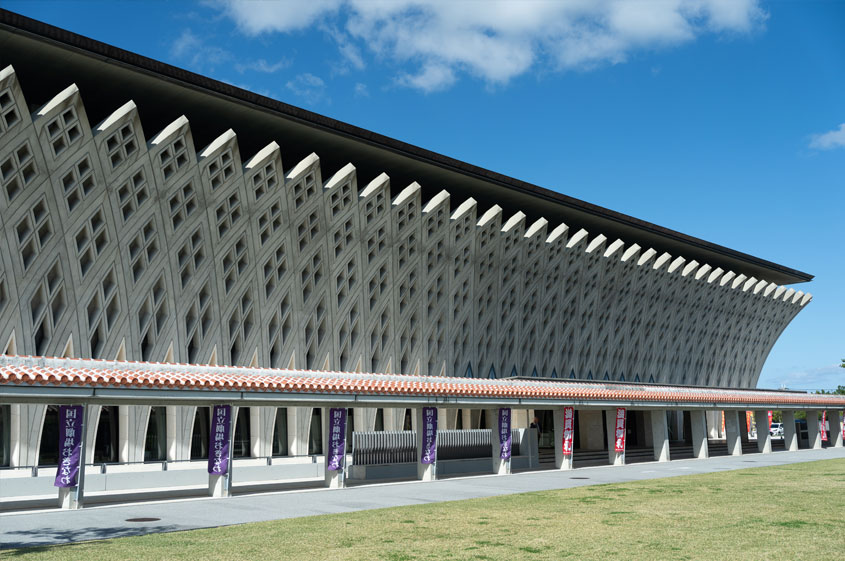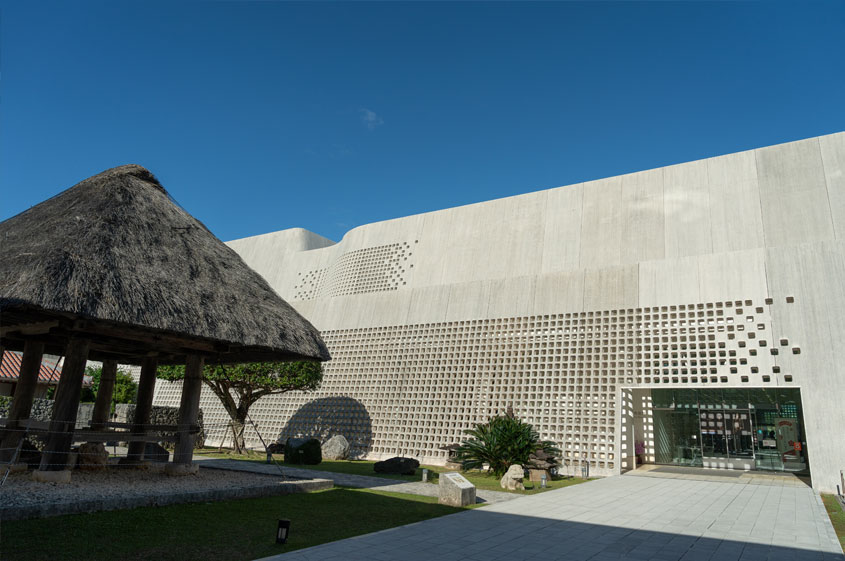Encountering Performing Arts and Learning about Their Backgrounds.
Tour Guide
Words by Mari Hashimoto

Kanze Noh Theater
The refinement and perfection of Noh as a sophisticated performing art took place from the 14th to 15th century. Four powerful Noh troupes used to perform at temples and shrines in Nara, Japan’s ancient capital. One of these troupes produced a series of talented Noh performers who perfected the artform, including Kan’ami, his son Zeami, and his grandsons. These men demonstrated an extraordinary ability for creation, performance and management. Their talents were recognized by Ashikaga Yoshimitsu, the shogun who ruled the warrior class back then, with the troupe becoming a powerful Noh school based mainly in Kyoto and Nara. From the 17th century onwards, during the reign of the Tokugawa shogunate, the school retained its prominence as the head of the Shiza Ichiryu (the four old schools of Kanze, Konparu, Hosho, and Kongo and the new Kita school). Known as Kanze, this group is still active today under the leadership of its 26th grand master Kiyokazu Kanze. In 2017, Kanze Noh Theater, the school’s headquarters, was relocated to Ginza 6-chome in Tokyo’s Chuo Ward. The theater stages over 130 Noh performances a year, including over 20 sponsored by the Kanze school, and it is also used as a multipurpose hall.




Kanze Noh Theater
- Place
- GINZA SIX B3F, 6-10-1 Ginza, Chuo-ku, Tokyo 104-0061
- Link
- https://kanze.net/en/publics/index/
Yarai Noh Theater
One of the Kanze school’s most distinguished families is the Kanze Yoshiyuki (Kanze Kyukokai), which set up as a branch family of the Kanze school at the start of the 20th century. The Kanze Yoshiyuki family is headquartered in Yarai Noh Theater in Yaraicho, a district in Tokyo’s Shinjuku Ward that still retains the atmosphere of Edo (the old name for Tokyo). The theater burnt down twice, once in the Great Kanto Earthquake (1923) and once during the Pacific War in the Bombing of Tokyo (1945), though it was rebuilt in 1952. Most of Tokyo’s Noh stages were destroyed in the 1945 conflagration, so although Yarai Noh Theater was rebuilt in 1952, this still makes it Tokyo’s second-oldest Noh theater. It continues to host many events, including regular performances by the Kanze Kyukokai. On March 2 this year, it will stage the 3rd “The Noh Theater SANPO in Yarai Noh Theater” event.




Yarai Noh Theater
- Place
- 60 Yarai-cho, Shinjuku, Tokyo, 162-0805
- Opening Hours
- 10:00 am to 5:00 pm
- Closed
- Please check the official website of each facility.
- Admissions
- Varies by performance.
- Link
- https://yarai-nohgakudo.com (Japanese Only)
National Noh Theatre
As with National Theatre Okinawa, the National Noh Theatre is a national theater run by the Japan Arts Council. It opened in 1983 in Sendagaya in Tokyo’s Shibuya Ward and principally hosts performances of Noh and Kyogen. It stages a variety of performances, from popular and famous plays to new or revived works, performed by some of Nohgaku’s most well-known actors. The theater also conducts activities to convey the appeal of Noh and Kyogen and is engaged in nurturing the next generation of performers, from supporting actors (waki) and musicians (hayashi), playing the flute (fue), small hand drum (kotsuzumi), large hand drum (otsuzumi), and stick drum (taiko), to Kyogen performers. Last year was the theater’s 40th anniversary and it will continue to hold anniversary performances until March 2024. The Masterpieces Exhibition of National Noh Theatre is also being held in the museum’s Exhibition Room until March 23. The exhibition displays works from the theater’s collection, including masks, costumes, song books and paintings from the 15th-19th centuries. In particular, it showcases new discoveries made during ongoing research conducted since the collection was formed, with research reports displayed alongside the masterpieces they cover.




National Noh Theatre
- Place
- 4-18-1 Sendagaya, Shibuya-ku, Tokyo 151-0051
- Link
- https://www.ntj.jac.go.jp/en/theatre/noh/
https://www2.ntj.jac.go.jp/unesco/noh/en/noh/
National Theatre Okinawa
National Theatre Okinawa is the newest of Japan’s five national theaters. It was established in 2004 in Jitchaku in Urasoe City, Okinawa Prefecture, with the goal of preserving and promoting Okinawa’s traditional performing arts. Located next to Naha City, the current seat of Okinawa’s prefectural government, Urasoe was once the capital during the Ryukyu Kingdom era. The theater was designed by the architect Shin Takamatsu (winner of the 47th BCS Prize and the 11th Public Buildings Award). Its rhomboid lattice-shaped exterior is modelled on the “chinibu” bamboo walls of traditional Okinawan houses, which are designed to let in air while blocking off the strong subtropical sunlight. Furthermore, the upper section juts out to create a space underneath like the “amahaji” eaves of traditional Okinawan houses, with the structure resembling a blooming flower. The interior comprises a large theater, a small theater and a rehearsal room. In 2005, one year after its opening, the museum began a Kumiodori training program to nurture a generation of very talented young dancers and actors (tachikata) and musicians (jikata), while also helping performers to hone their skills. Shinji Kinjo was among the theater’s first group of trainees and he now serves as artistic director of National Theatre Okinawa. Besides Kumiodori dance, the theater stages a variety of performances, including sanshin recitals, Okinawan plays, and Ryukyuan dance. It also hosts performances of folk performing arts, principally from Okinawa Main Island, and Kyogen from the Japanese mainland.




National Theatre Okinawa
- Place
- 4-14-1 Jitchaku, Urasoe City, Okinawa Prefecture 901-2122, Japan
- Opening Hours
- 10:00 AM to 6:00 PM (However, if there is a performance in the evening, the theatre closes 30 minutes after the performance ends.)
- Closed
- New Year holidays (December 29th to January 3rd)
- Admissions
- Varies by performance.
- Link
- https://www.nt-okinawa.or.jp/english/ticket-information
Okinawa Prefectural Museum & Art Museum
Known affectionately as “Okimyu,” Okinawa Prefectural Museum & Art Museum is Okinawa Prefecture’s largest cultural facility, comprising both a museum and an art museum. Its origins date back to the Okinawa Civilian Administration Higashi Onna Museum, which was founded in 1946 after the Battle of Okinawa. Thereafter, a project began to rebuild the ageing prefectural museum and combine it with the first prefectural art museum to form a multi-purpose complex located in Naha City’s new downtown area. After many trials and tribulations, the project was finally realized in 2007. The complex was jointly designed by Ishimoto Architectural & Engineering Firm and Niki Architects Associates. It is modelled on the Ryukyu Kingdom’s gusuku castles (the word “gusuku” refers to sanctuaries or fortresses built on small hills or rocky mountains). The double-skin walls utilize Okinawan limestone, which lessens the impact of typhoon storms and intense sunlight, while the numerous holes in the walls allow for natural illumination, just like sunshine filtering through foliage, with the design skillfully providing both shade and ventilation. The museum’s permanent exhibitions feature materials from a variety of fields, including natural history, archaeology, folklore, history, and arts and crafts. The Art Museum Collection Exhibition primarily consists of modern and contemporary artwork formed within the climate of Okinawa, including oil paintings, watercolor paintings, sculptures, prints, photographs and videos. The museum should be your first port of call should you wish to learn more about Okinawa.




Okinawa Prefectural Museum & Art Museum
- Place
- 3-1-1 Omoromachi, Naha-shi, Okinawa 900-0006
- Opening Hours
- Tuesday, Wednesday, Thursday, and Sunday:
9am-6pm(Last admission is at 5:30 p.m.)
Friday and Saturday:
9am-8pm(Last admission is at 7:30 p.m.)
*These days are subject to change. - Closed
- Every Monday*
*If Monday is a public or national holiday, the museum will be open, and then it will be closed the following business day.
New Year's holiday:
December 29th to January 3rd
*These days are subject to change. - Admissions
- Permanent Exhibition:
Museum
General admission (18-69 yrs.) Individual 530 Yen Group 420Yen
High School & College Students Individual 270 Yen Group 220Yen
(Non-prefectural) Elementary & Junior High School Students Individual 150 Yen Group 120Yen
Art Museum
General admission (18-69 yrs.) Individual 400 Yen Group 320Yen
High School & College Students Individual 220 Yen Group 180Yen
(Non-prefectural) Elementary & Junior High School Students Individual 100 Yen Group 80Yen
* All fees noted above are per person.
* Individuals 70 years or older may view all permanent exhibts free of charge. (Please make sure to bring identification in order to verify your age.)
* Note: Discounted admission rates are offered for groups of 20 or more.
* credit card is not accepted.
Special and Planned Exhibitions:
Admisison fees for these exhibitions vary. - Link
- https://okimu.jp/en/
Sefa Utaki
Sefa Utaki was the Ryukyu Kingdom’s holiest place. It was used to stage inauguration ceremonies for kikoe-ogimi, the high priestesses who headed the Ryukyu Kingdom’s religious organization. From the mid-15th century, meanwhile, Sefa Utaki was subject to royal visits as a sacred site associated with the Ryukyu Kingdom’s creation myths and played an important role as a site for the national rituals that provided religious and spiritual support to royal authority. However, as a sacred utaki directly under the control of the kingdom’s Shuri administration, the site was off limits to regular folk during the Ryukyu Kingdom era, with people only able to visit freely from the Meiji era (1868–1912).
Traces of human activity in Sefa Utaki (earthenware and animal bones) date back to the Yayoi period (ca. 5th century BC–3rd century AD), though it is unclear when people began to consider it a sacred religious site. Sefa Utaki has sanctuaries named Ufugui, Yuinchi, Sangui and Chonohana, with the former three connected by a stone-paved approach. The scenery of giant overhanging rocks emphasizes the divine nature of the location. It is not just a historic site either, with many people still visiting today to offer solemn prayers, including those taking part in “Agariumai,” a pilgrimage around the area’s holy places undertaken with one’s own kin group (or “munchu”). As such, the place is revered as “a living cultural landscape” that represents Okinawa’s spiritual culture. Sefa Utaki was designated as a National Historical Site in 1972, and in 2000 it was registered as a UNESCO World Heritage site as part of the “Gusuku Sites and Related Properties of the Kingdom of Ryukyu.”




World Cultural Heritage Sefa-utaki
- Place
- Ticket office: Nanjo City Local Products Center 539 Chinen-kudeken, Nanjo City, Okinawa
- Opening Hours
- March-October:
9:00~18:00
Final Ticket sales 17:15 / Last Admission 17:30
November-February:
9:00~17:30
Final Ticket sales 16:45 / Last Admission 17:00 - Closed
- Nov.13,2023~Nov.15,2023
Jun.6,2024~Jun.8,2024
Nov.1,2024~Nov.3,2024
May27,2025~May29,2025
Note: Twice a year (May 1-3 and October 1-3 in the lunar calendar) in order to secure the silence as a sacred place and to preserve the nature. - Admissions
- Adult (16years old and over) : 300yen
Children (From 7 to 15 years old) : 150yen
Group (more than 20 people) : 200yen - Link
- https://okinawa-nanjo.jp/sefa/en/

